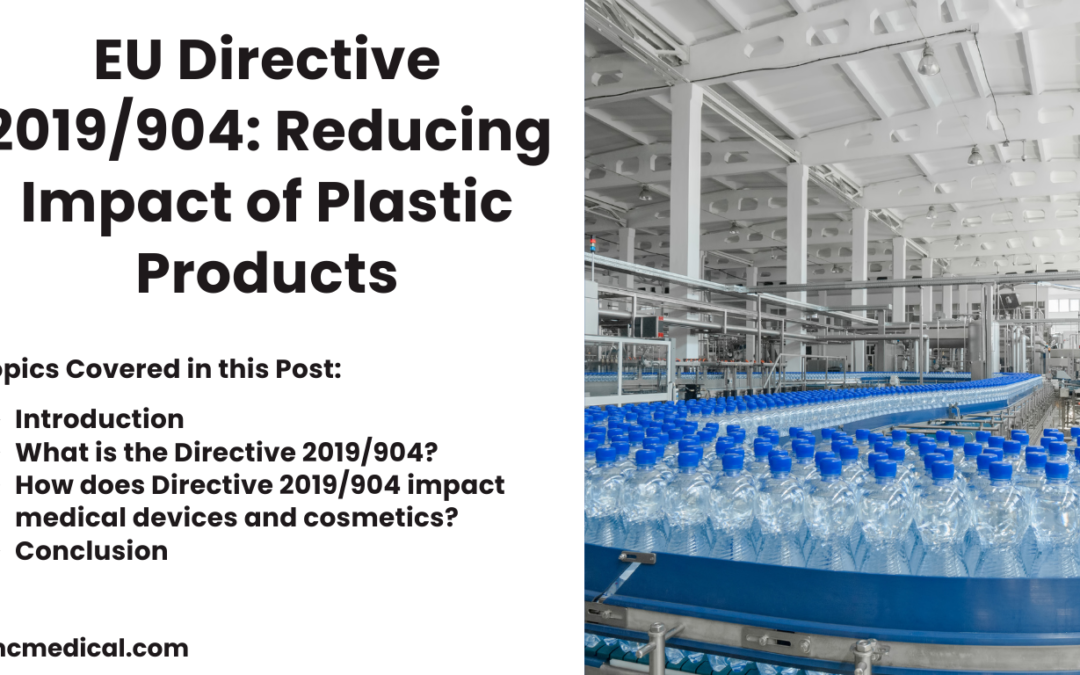
by OMC Medical | Apr 12, 2024 | EU, General Information
Introduction
Directive 2019/904 aims to mitigate the environmental and health impacts of specific plastic products, particularly in aquatic environments, while fostering the transition towards a circular economy through innovative and sustainable practices.
It encompasses single-use plastic items outlined in the Annex and products made from oxo-degradable plastic and plastic-containing fishing gear.
Member States are mandated to implement measures to significantly reduce the consumption of single-use plastic products listed in Part A of the Annex, aligning with the broader goals of the EU’s waste management policy, notably waste prevention.
What is the Directive 2019/904?
Adopted in June 2019, this directive aims to reduce the environmental impact of certain plastic products, particularly single-use plastics (SUPs). SUPs are defined as any plastic item designed for single use and not intended to be reused.
Due to its versatile functionality and cost-effectiveness, plastic has become increasingly pervasive in various aspects of daily life.
While it serves crucial roles in many industries, its extensive use in disposable applications, which are often not designed for reuse or efficient recycling, has led to inefficient and linear production and consumption patterns.
Recognizing this challenge within the Circular Economy Action Plan outlined in the Commission’s communication of December 2, 2015, titled ‘Closing the Loop – An EU Action Plan for the Circular Economy,’ the Commission emphasized in its European Strategy for Plastics, articulated in the communication of January 16, 2018, titled ‘A European Strategy for Plastics in a Circular Economy,’ the urgent need to address the escalating generation of plastic waste and its leakage into the environment, notably marine ecosystems.
This strategy aims to transition towards a circular economy where plastic design and production prioritize reuse, repair, and recycling while promoting the development and adoption of more sustainable materials.
Given the significant adverse environmental, health, and economic impacts of certain plastic products, establishing a specific legal framework is deemed necessary to mitigate these negative effects effectively.
The objective of this directive is to prevent and reduce the impact of certain plastic products on the environment, in particular the aquatic environment, and on human health, as well as to promote the transition to a circular economy with innovative and sustainable business models, products and materials, thus also contributing to the efficient functioning of the internal market.
This Directive applies to the single-use plastic products listed in the Annex, to products made from oxo-degradable plastic and to fishing gear containing plastic.
What is Directive 2019/904?
Under this Directive, ‘plastic’ means a material consisting of a polymer as defined in point 5 of Article 3 of Regulation (EC) No 1907/2006, to which additives or other substances may have been added and which can function as a primary structural component of final products, with the exception of natural polymers that have not been chemically modified.
‘Single-use plastic product’ means a product made wholly or partly from plastic and that is not conceived, designed, or placed on the market to accomplish multiple trips or rotations within its life span by being returned to a producer for refill or re-used for the same purpose for which it was conceived.
How does Directive 2019/904 impact medical devices and cosmetics?
The Single-Use Plastics (EU Directive 2019/904) has a minimal direct impact on most medical devices and cosmetics. This is because the directive targets a specific list of single-use plastic items, and most medical devices and cosmetics do not use single-use plastics for packaging.
Medical devices and cosmetics have their own separate regulations (EU 2017/745 and EC No 1223/2009, respectively) that address packaging safety and materials.
However, there’s an indirect influence on medical devices and cosmetics, which ensures a Sustainability Push. The SUP Directive promotes a general shift towards reducing plastic use. This can indirectly pressure manufacturers of medical devices and cosmetics to:
- Minimize Plastic Packaging: They might explore alternative packaging materials or reduce plastic use.
- Use Recycled Plastic: Manufacturers could utilize recycled plastic content in their packaging to comply with the spirit of the directive.
Overall, SUPs might be used in medical devices and cosmetic packaging, but the SUP Directive doesn’t directly regulate them. It creates a broader push for sustainable practices that can indirectly influence packaging choices in these industries.
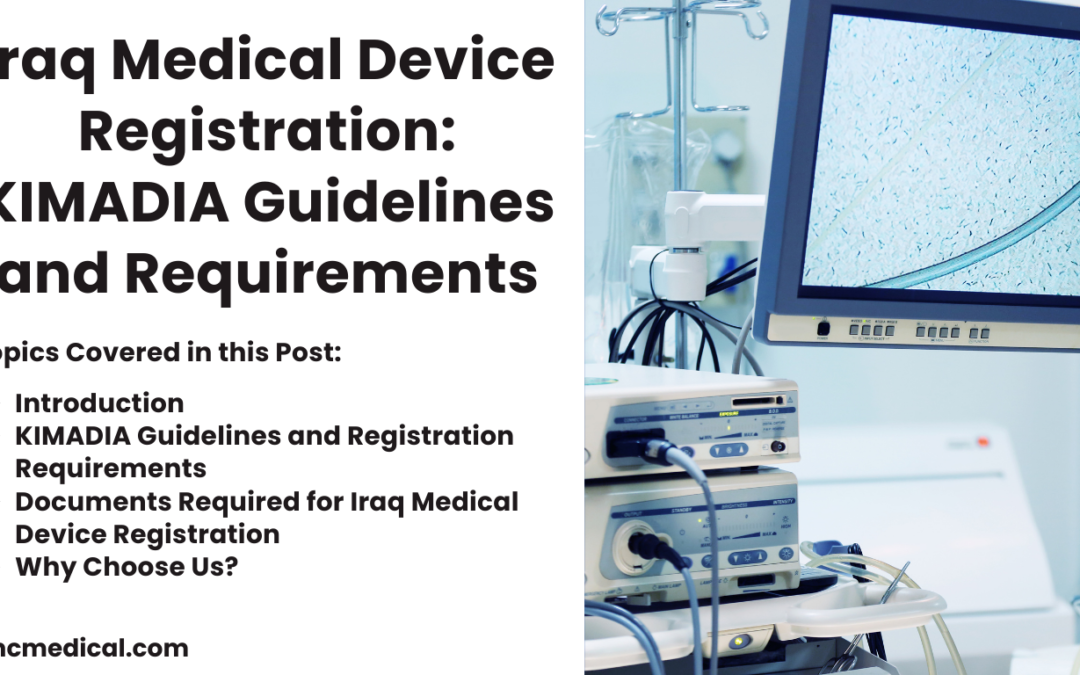
by OMC Medical | Apr 4, 2024 | Registration
Navigating Medical Device Registration with Iraq’s Regulatory Authority: KIMADIA Guidelines and Requirements
Regulatory Authority: State Company for Marketing Drugs and Medical Appliances (KIMADIA)
“Kimadia” refers to the Iraqi State Company for Marketing Drugs and Medical Appliances. It is a governmental organization responsible for procuring and distributing pharmaceuticals and medical supplies within Iraq, including through tenders and procurement processes.
When “Kimadia” issues tenders for medical devices, they may require that legal manufacturers and manufacturing sites be registered through a country-specific form. This registration process ensures that the manufacturers and manufacturing sites comply with Iraqi regulations and standards for medical devices.
Ministry Of Health: Iraqi Ministry of Health
Classification: Class A, B, C, D
KIMADIA Guidelines and Registration Requirements
- Registration of the foreign supplier at the Ministry of Health (MOH) Registration Board.
- For each consignment to the private sector, documents must be presented before an import license will be issued by the MOH.
- For sales under The State Company for Marketing Drugs and Medical Appliances (KIMADIA) tenders, a complete set of documents must be presented before an import license will be issued by the MOH.
Documents Required for Iraq Medical Device Registration
- Company registration form to be filled in one copy Signed and stamped by the person responsible on the establishment.
- Quality assurance certificate such as ISO 9001, 9002 or equivalent.
- Manufacturer registration certificate in the country of origin officially legalized.
- Spread data sheet of the company products (catalogue)
- Certification letter regarding the boycott with Israel.
- Company registration fee $ 1000.
- Manufacturer registration certificate in the C.O.O, and the LoA.
- Certificates of Free Sale (CFSs) are required for: general medical devices; active implantable medical devices and in vitro diagnostic medical devices as well as a mixture of the above devices.
License Validity
Registrations need to be renewed after five years, in most cases.
Additional Comments
- All submitted documents need to be properly legalised and stamped, as per Iraqi law.
- For products originating from certain countries, and in certain cases, the Ministry of Health will require the applying party to pay for Ministry inspectors to visit and inspect production facilities.
- Separate import licenses are needed for each shipment, obtained through the MOH.
- For tenders through KIMADIA, a specific registration process might apply.
Who should make this Communication?
- Manufacturer
- Authorized Representative
When to make this communication?
Before placing a medical device into the market.
How OMC Medical can assist you with the process?
- Act as your Authorized representative
Why Choose Us ?
- Working towards client satisfaction
- Cost effective solutions
- Project completion before deadline
- Quality Regulatory affairs solutions
Contact us for free consultation: [email protected]
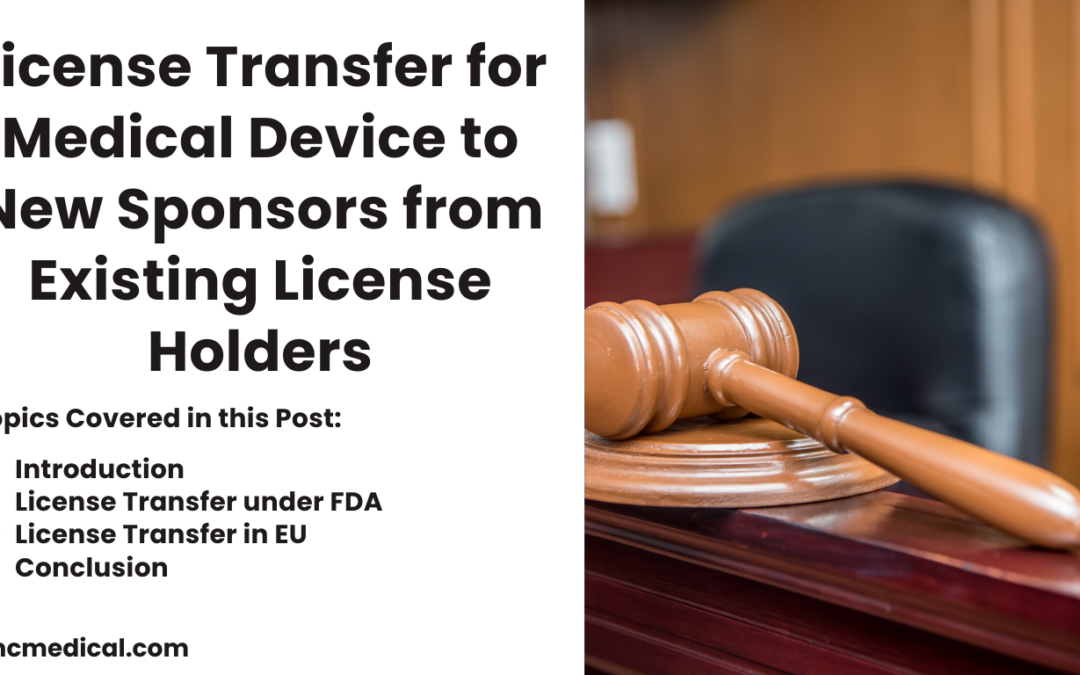
by OMC Medical | Apr 3, 2024 | General Information
License transfer for medical devices is a crucial aspect of the regulatory landscape governing the manufacturing and distribution of medical products. It allows existing license holders to transfer the rights to manufacture and market a specific medical device to a new sponsor or entity.
This process is essential for ensuring the continued availability and safety of medical devices in the market.
License transfer allows for the continued availability of medical devices in the market, even as ownership of the licenses changes hands. This ensures that patients have access to essential medical treatments without interruptions or delays.
Additionally, license transfer promotes innovation and competition in the medical device industry. Companies that acquire licenses for new devices can bring fresh perspectives, resources, and expertise to the development and marketing of these products.
This can lead to the introduction of new and improved medical devices that benefit patients and healthcare providers.
License Transfer under FDA
The regulation of medical devices is an important aspect of ensuring patient safety and the effectiveness of medical treatments. In the United States, the Food and Drug Administration (FDA) is responsible for regulating medical devices and ensuring that they meet certain safety and efficacy standards.
In order to bring a medical device to market, companies must obtain a license from the FDA, which allows them to manufacture, distribute, and sell the device.
When a company wishes to transfer a medical device license to a new sponsor, there are certain steps that must be followed to ensure that the transfer is conducted properly.
The FDA requires that the new sponsor submit a transfer request, along with documentation demonstrating their ability to comply with the terms of the existing license. Additionally, the new sponsor must pay a transfer fee to the FDA in order to complete the transfer process.
License Transfer in EU
The MDR represents a significant overhaul of the regulatory framework for medical devices in the EU, aiming to enhance patient safety and ensure the effectiveness and reliability of medical devices on the market.
As part of the MDR, the process of license transfer was introduced to enable the seamless transition of licenses from existing holders to new sponsors, thereby facilitating the continued availability of medical devices to patients across Europe.
Key figures in the development and implementation of the process of license transfer for medical devices in the EU include regulatory authorities such as the European Commission, the European Medicines Agency (EMA), and national competent authorities in EU member states.
These entities play a vital role in overseeing the regulatory requirements for license transfers and ensuring that new sponsors meet all necessary criteria for compliance with the MDR.
In addition, manufacturers, notified bodies, and other stakeholders in the medical device industry also play a crucial role in the process of license transfer, working together to ensure the safety and quality of medical devices on the market.
The process of license transfer enables greater flexibility for manufacturers and sponsors, allowing for changes in ownership without disrupting the availability of medical devices to patients.
This can facilitate innovation and investment in the medical device industry, leading to the development of new and improved products that can benefit patients and healthcare providers.
Transferring the license for a medical device to a new sponsor from an existing license holder in the European Union (EU) involves several steps to ensure compliance with EU regulations, particularly those outlined in the Medical Devices Regulation (MDR) or the In Vitro Diagnostic Medical Devices Regulation (IVDR), depending on the classification of the device.
Here’s a general outline of the process:
- Notification to Competent Authority: The current license holder (existing sponsor) must notify the competent authority in the EU member state where the device is placed on the market about the intended transfer of the license to the new sponsor. The competent authority varies depending on the country, for example, in Germany, it’s the Federal Institute for Drugs and Medical Devices (BfArM).
- Submission of Application by New Sponsor: The new sponsor must submit an application for the transfer of the license to the competent authority in accordance with the requirements of the relevant regulations (MDR or IVDR). The application typically includes information about the device, its intended use, manufacturing details, quality management system, and any other relevant documentation.
- Review and Evaluation by Competent Authority: The competent authority will review the application submitted by the new sponsor to ensure compliance with regulatory requirements. This review may involve assessing the conformity of the device with applicable standards, verifying the quality management system of the new sponsor, and evaluating the technical documentation.
- Approval of License Transfer: If the competent authority determines that the new sponsor meets all necessary requirements and that the transfer of the license will not compromise the safety or effectiveness of the medical device, they will approve the transfer.
- Notification to Notified Body (if applicable): If the device requires involvement of a notified body (e.g., for conformity assessment under MDR or IVDR), the new sponsor must also notify the notified body about the change in sponsorship. The notified body may need to update relevant certificates or conduct additional assessments as necessary.
- Notification to Economic Operators: Both the current and new sponsors must notify relevant economic operators, such as authorized representatives, importers, and distributors, about the change in sponsorship. This ensures that all stakeholders are aware of the new sponsorship and can update their records accordingly.
- Ongoing Regulatory Compliance: The new sponsor is responsible for ensuring ongoing regulatory compliance with EU regulations, including maintaining appropriate documentation, reporting adverse events, conducting post-market surveillance, and fulfilling any other regulatory obligations.
Regulatory agencies, such as the FDA, generally view license transfer as a necessary and beneficial process that ensures the continued availability and safety of medical devices.
These agencies work closely with industry stakeholders to facilitate the smooth transfer of licenses and to uphold high standards of quality and compliance.
In conclusion, license transfer for medical devices is a critical aspect of the regulatory framework governing the manufacturing and distribution of medical products. It has a significant impact on patient care, innovation, competition, and access to medical devices.
By exploring historical context, key figures, impact, influential individuals, perspectives, and future developments related to license transfer, we can gain a deeper understanding of this complex and dynamic field and work towards improving patient outcomes and healthcare delivery.
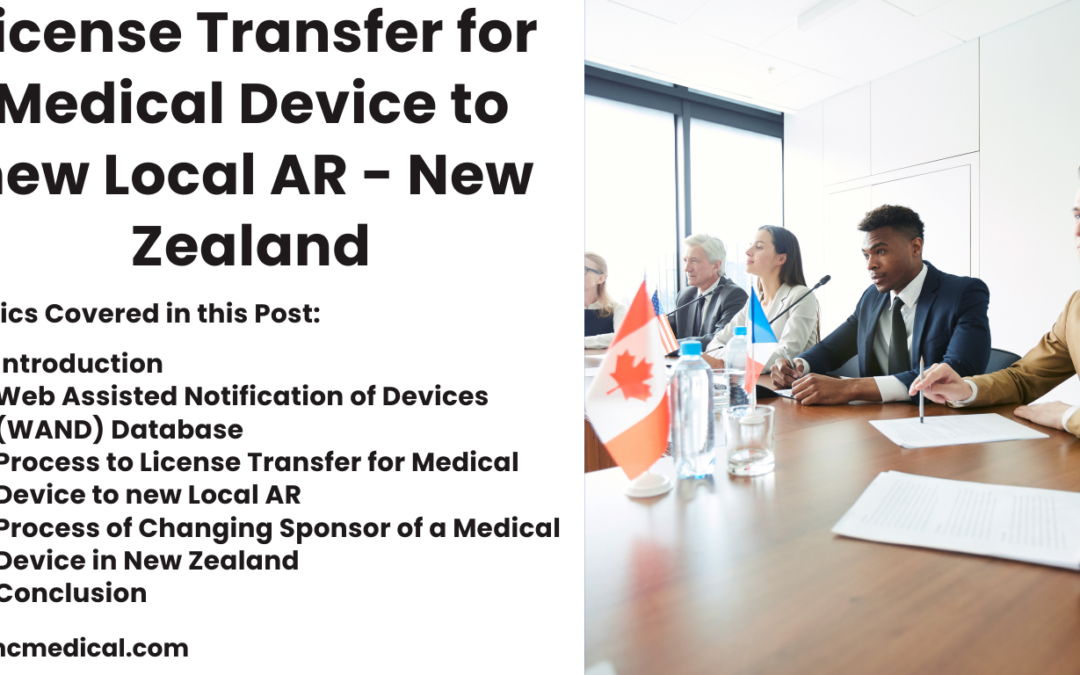
by OMC Medical | Apr 3, 2024 | General Information
Medical devices play a crucial role in healthcare by diagnosing, treating, and monitoring various medical conditions. These devices are designed and manufactured by companies that must obtain licenses to sell their products in different markets.
When a company wants to transfer the license for a medical device to a new local Authorized Representative (AR) in a different country, such as New Zealand, there are several key steps and considerations that must be taken into account.
Transferring the license for a medical device to a new local AR in New Zealand is a complex process that requires careful planning and coordination. The first step in the license transfer process is for the company to identify a new local AR in New Zealand who is qualified and authorized to represent the company in the country.
The new AR must meet all regulatory requirements and have a thorough understanding of the local laws and regulations governing medical devices in New Zealand.
Web Assisted Notification of Devices (WAND) Database
On January 1, 2004, the Medicines (Database of Medical Devices) Regulations 2003 came into effect. According to the legislation, a sponsor—a person or organisation that manufactures, imports, or exports medical devices into or out of New Zealand—must notify a database of the specifics of the devices within 30 days of the device being sold or exported.
This database is called the Web Assisted Notification of Devices (WAND) database.
It is mandatory for sponsors to keep up with the data submitted to the WAND database. In the event that sponsors find information placed into the WAND database to be inaccurate or incomplete, they must update or amend the information within ten working days of the discovery.
A WAND device notification number is a special code that designates a certain sponsor, manufacturer, and device combination. Therefore, in the event that supply agreements in New Zealand alter, it is not possible to transfer a device notification from one sponsor to another.
The new sponsor, Sponsor B, is required to inform the devices to the WAND database, and Sponsor A, the present sponsor, must render the pertinent device notifications outdated.
Process to License Transfer for Medical Device to new Local AR
Sponsors are recommended to follow the procedure outlined below when a change of sponsor is required.
- One month prior – Sponsor B to apply for access to the WAND database, if not already a sponsor.
- One month prior – Sponsor B to request from the manufacturer information about the intended purpose and GMDN codes in preparation for making the new device notification.
- On the date of the change – Sponsor B to begin notifying the transferred device(s) to the WAND database.
- Within 10 days of the change – Sponsor A to make obsolete all of the affected notifications to the WAND database.
- Within 30 days of the change – Sponsor B to complete notifying the transferred device(s) to the WAND database.
- Optional – Sponsors A and B to advise their customers of the change in WAND numbers for the transferred devices.
Process of Changing Sponsor of a Medical Device in New Zealand
Changing the sponsor of a medical device in New Zealand involves a series of steps to ensure compliance with regulatory requirements.
Here’s a general outline of the process:
- Notification to the New Zealand Medicines and Medical Devices Safety Authority (Medsafe): The current sponsor of the medical device must notify Medsafe about the intended change in sponsorship. This notification typically includes details such as the name and contact information of the new sponsor, as well as any relevant documentation regarding the change.
- Submission of Application by the New Sponsor: The new sponsor must submit an application to Medsafe for approval to become the sponsor of the medical device. This application usually includes information about the device, its intended use, manufacturing details, quality control measures, and any other relevant documentation.
- Review and Evaluation by Medsafe: Medsafe will review the application submitted by the new sponsor to ensure compliance with regulatory requirements. This review may involve assessing the safety, efficacy, and quality of the medical device, as well as verifying the qualifications and capabilities of the new sponsor.
- Approval of Change in Sponsorship: If Medsafe determines that the new sponsor meets all necessary requirements and that the change in sponsorship will not compromise the safety or effectiveness of the medical device, they will approve the change.
- Notification to Relevant Parties: Once the change in sponsorship is approved, both the current and new sponsors must notify relevant parties, such as healthcare professionals, distributors, and regulatory authorities, about the change. This notification ensures that all stakeholders are aware of the new sponsorship and can update their records accordingly.
- Ongoing Regulatory Compliance: The new sponsor is responsible for ensuring ongoing regulatory compliance with Medsafe requirements. This includes maintaining appropriate documentation, reporting adverse events, conducting post-market surveillance, and adhering to any other regulatory obligations.
Conclusion
The process of transferring licenses for medical devices to new local ARs in New Zealand has had a significant impact on the industry. By requiring foreign manufacturers to appoint a local representative, the government aims to improve the oversight of medical devices in the country and ensure that they meet the necessary standards for safety and efficacy.
This has led to increased transparency and accountability in the industry, as local ARs are required to report any adverse events or quality issues related to the devices they represent.
Another positive aspect of license transfer is the potential for increased collaboration and knowledge sharing between foreign manufacturers and local ARs.
By working together, these stakeholders can learn from each other’s expertise and experiences, leading to improved processes and outcomes in the industry.
Overall, transferring the license for a medical device to a new local AR in New Zealand is a complex process that requires careful planning and coordination.
By working closely with the new local AR and ensuring that all regulatory requirements are met, companies can successfully transfer their license and bring their medical devices to market in New Zealand.
This process helps to ensure that patients in New Zealand have access to safe and effective medical devices that can improve their quality of life.
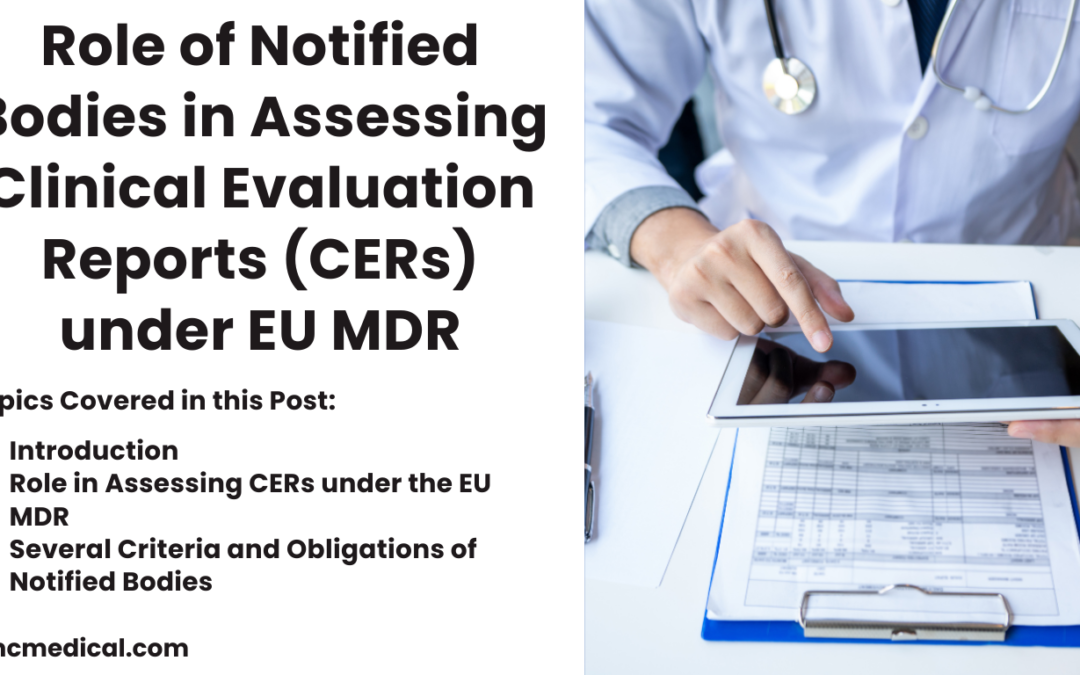
by OMC Medical | Mar 27, 2024 | EU MDR, General Information
Clinical evaluation is a continuous procedure that happens at every stage of a medical device’s life cycle. It is typically carried out initially in the course of developing a medical device to determine what data must be produced to gain access to the market.
The first CE-marking must include a clinical evaluation, and it must be regularly updated going forward.
Clinical evaluation is essential and significant because it guarantees that assessments of the device’s performance and safety are grounded on adequate clinical evidence on the market.
Through this continuous procedure, manufacturers can give notified bodies and appropriate authorities enough clinical evidence to show that the device complies with the Essential Requirements for its life.
To support the evidence of a product’s compliance with the Essential Requirements of the applicable Directive, medical device manufacturers produce clinical evaluation reports and accompanying documentation, which the notified body evaluates and verifies.
Appendix A12 (Activities of Notified Bodies) contains comprehensive suggestions for notified bodies. These consist of:
- Advice for notified bodies regarding the evaluation of clinical assessment reports that manufacturers of medical devices supply as part of technical documentation (such as design dossiers); and
- advice for notified bodies regarding the creation of internal protocols for the evaluation of clinical aspects associated with medical devices.
Furthermore, referring to the Notified Bodies Operations Group (NBOG) papers is recommended. Checklists, forms, and best practice recommendations are all included in NBOG documents.
Under the European Medical Device Regulation (MDR), notified bodies play a crucial role in assessing the conformity of medical devices before they can be placed on the market. The EU MDR (Medical Device Regulation) is a regulatory framework governing medical devices within the European Union.
It aims to ensure the safety and performance of such devices while enhancing transparency and traceability throughout the supply chain.
Notified bodies are organizations designated by EU member states and authorized by the European Commission to conduct conformity assessments of medical devices.
Their main responsibility is to evaluate whether medical devices meet the requirements set forth in the EU MDR and comply with relevant harmonized standards.
Role in Assessing Clinical Evaluation Reports (CERs) under the EU MDR
Here’s an overview of their role in assessing CERs under the EU MDR:
1. Reviewing Clinical Evaluation Reports (CERs)
Notified bodies are responsible for reviewing the Clinical Evaluation Reports submitted by medical device manufacturers. These reports are essential documents that demonstrate the safety and performance of the medical device based on clinical data and literature review.
Overall, notified bodies play a critical role in ensuring the quality, reliability, and compliance of Clinical Evaluation Reports under the EU MDR, thereby contributing to the safety and effectiveness of medical devices marketed within the European Union.
2. Assessing Compliance with Regulatory Requirements
Notified bodies assess whether the CERs comply with the requirements outlined in the EU MDR. This includes verifying that the clinical data presented in the CERs are relevant, valid, and sufficient to demonstrate the safety and performance of the medical device throughout its lifecycle.
3. Verification of Clinical Data
Notified bodies verify the integrity and reliability of the clinical data presented in the CERs. They assess whether the data sources used in the clinical evaluation are appropriate and whether the analysis and conclusions drawn from the data are scientifically sound.
4. Assessing clinical evidence
Notified bodies employ experts with the necessary clinical, scientific, and technical expertise to evaluate CERs effectively. These experts assess the clinical evidence presented in the reports to ensure it supports the medical device’s intended purpose and claims.
5. Post-Market Surveillance
Notified bodies also play a role in post-market surveillance activities related to clinical data. They may review post-market clinical follow-up data and reports to ensure ongoing compliance with regulatory requirements and to assess the continued safety and performance of the medical device.
6. Interaction with Competent Authorities
Notified bodies collaborate with competent authorities, such as national regulatory agencies, to ensure consistency in the assessment of CERs and to address any concerns or issues that may arise during the evaluation process.
7. Granting of CE Marking:
Based on their assessment of the CERs and other conformity assessment activities, notified bodies to determine whether a medical device meets the requirements for CE marking.
CE marking indicates that the device complies with the applicable regulatory requirements and can be placed on the market within the European Union.
Under the European Medical Device Regulation (EU MDR), notified bodies are designated organizations responsible for assessing the conformity of medical devices with regulatory requirements before they can be placed on the market or put into service within the European Union.
Several Criteria and Obligations of Notified Bodies
To meet the EU MDR requirements, notified bodies must adhere to several criteria and obligations.
1. Designation and Accreditation
Notified bodies must be designated by a Member State and accredited to conduct conformity assessments of medical devices according to the requirements of the EU MDR.
They must demonstrate compliance with ISO/IEC 17000 series standards for conformity assessment.
2. Technical Competence
Notified bodies must possess and maintain the necessary technical expertise and competence to assess the conformity of medical devices with the relevant requirements of the EU MDR.
This includes expertise in areas such as clinical evaluation, risk management, quality management systems, and regulatory affairs.
3. Independence and Impartiality
Notified bodies must operate independently and impartially, free from any undue influence that could affect the objectivity or integrity of their conformity assessment activities. They must establish and maintain procedures to manage conflicts of interest effectively.
4. Quality Management System
Notified bodies must have a quality management system (QMS) in place that meets the requirements of the EU MDR. This QMS should ensure the consistent and reliable performance of conformity assessment activities, including document control, personnel competence, and audit processes.
5. Assessment Procedures
Notified bodies must establish and maintain documented procedures for conducting conformity assessments of medical devices.
These procedures should outline the steps and criteria for evaluating devices’ conformity with applicable requirements, including clinical evaluation, technical documentation review, and quality management system assessment.
6. Competent Personnel
Notified bodies must employ personnel with the qualifications, expertise, and experience to perform their duties effectively. This includes experts in various relevant fields, such as clinical evaluation, regulatory affairs, biomedical engineering, and quality assurance.
7. Transparency and Communication
Notified bodies must ensure transparency in their operations and communicate effectively with manufacturers, authorities, and other stakeholders. They must provide transparent information about their processes, fees, timelines, and any decisions made regarding conformity assessment.
8. Monitoring and Surveillance
Notified bodies are subject to ongoing monitoring and surveillance by competent authorities to ensure compliance with the EU MDR requirements.
This includes regular audits, assessments, and inspections to verify the competence and performance of notified bodies in conducting conformity assessments.
By fulfilling these requirements, notified bodies play a crucial role in ensuring the safety, quality, and effectiveness of medical devices placed on the market within the European Union under the EU MDR regulatory framework.




